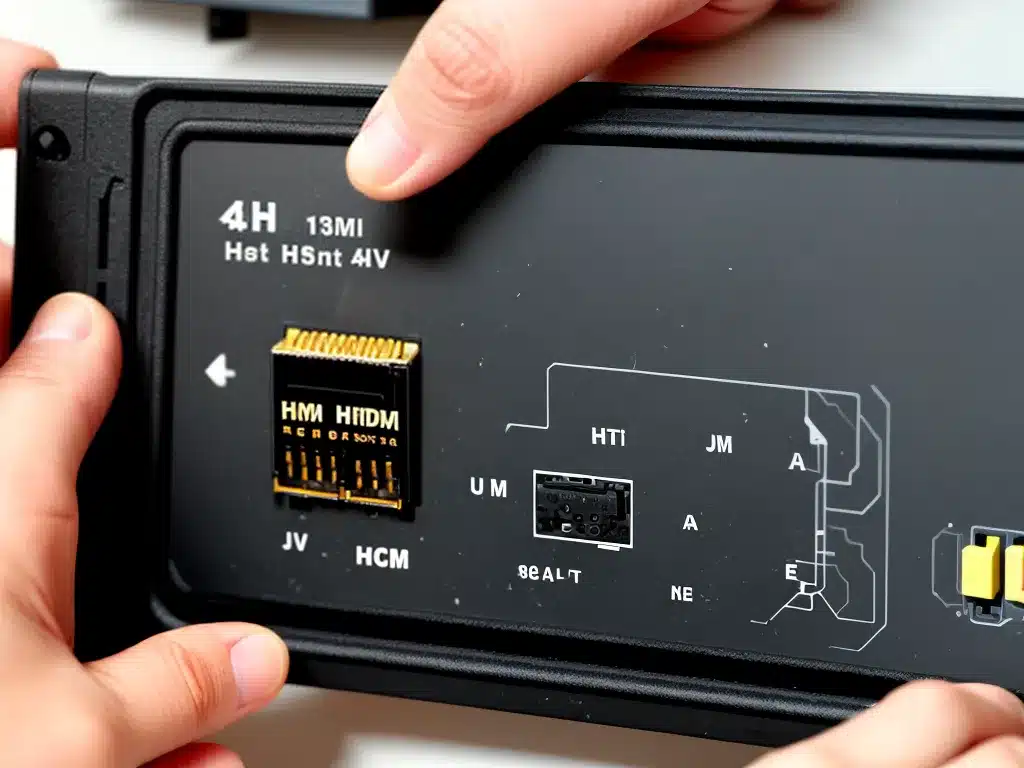
Introduction
Having issues with HDMI ports not working can be incredibly frustrating. However, in many cases, there are fixes you can try yourself to get your HDMI ports functioning again. In this article, I will provide an in-depth look at reasons your HDMI port may not be working, troubleshooting steps to diagnose the issue, and potential solutions to restore connectivity.
Common Reasons an HDMI Port May Not Work
There are a few main reasons why an HDMI port may not be working properly:
Loose Cable Connection
One of the simplest explanations is a loose HDMI cable. If the cable is not securely inserted into the port, it can cause connectivity issues. Check both ends of the cable to ensure they are fully plugged in.
Damaged Cable
HDMI cables can become bent or frayed over time, resulting in damage to the wiring inside the cable. A damaged HDMI cable is unable to transmit the digital video and audio signal properly. Try using a different HDMI cable that is known to work to see if that resolves the problem.
Damaged HDMI Port
It’s possible for the HDMI port itself to become damaged, either from the repeated plugging and unplugging of cables, or from excessive force used when connecting cables. Damaged ports may have broken or bent pins that disrupt connectivity.
Incorrect Input Source Selected
If you have multiple devices connected to your TV, make sure the correct input source is selected on your TV. For example, if your cable box is connected to HDMI 1 but your TV input is set to HDMI 2, you won’t get any signal.
Software/Driver Issues
For HDMI ports on computers, issues with graphics drivers, operating systems or firmware could potentially lead to connectivity problems with the HDMI output.
Troubleshooting Tips
If your HDMI port is not working correctly, there are some basic troubleshooting steps you can take:
-
Try different cables – Switch out cables to determine if the issue is being caused by a faulty cable.
-
Check connections – Remove cables from the ports and reconnect them securely. Ensure connections are snug.
-
Test devices/inputs – Connect the same device and cable to another TV or input source. This helps identify if the problem is with the device or the TV’s port.
-
Reset devices – Turn devices completely off and back on. Or perform a hard reset if possible.
-
Update firmware/drivers – For computers and other devices, ensure you have installed the latest firmware and driver updates.
-
Change ports – Try connecting your device to a different HDMI port on the TV to see if another port works correctly.
-
Adjust resolution – Problems can sometimes occur when the input resolution exceeds the TV’s capabilities. Try lowering the output resolution on your device.
Solutions for a Broken HDMI Port
If you’ve gone through the troubleshooting steps but determined the HDMI port itself is damaged, here are some potential solutions:
Use a Different Port
If possible, connect your device to a different functioning HDMI port on your TV or computer. Most TVs and video cards have multiple ports. This allows you to bypass the broken port.
Replace HDMI Cable
While the cable may not be the root cause, trying a new high-speed HDMI cable could potentially improve connectivity issues if the wiring inside the current cable is damaged.
Replace Device
For older devices, it may not be cost-effective to repair an HDMI port. Replacing the device altogether can ensure you get a functioning HDMI output. Before replacing, check if the device is still under warranty.
Use Adapter
For televisions, you can purchase an HDMI wall plate adapter that will covert the port on the back of your TV to a standard HDMI port. This allows you to connect devices without using the built-in, damaged port.
Professional Repair Service
For high-end TVs and computers, it may be worthwhile to utilize a professional repair service to fix the damaged HDMI port. They can diagnose issues and solder connections on the board. This route is more expensive but restores functionality.
DIY HDMI Port Fix
There are some DIY techniques online for repairing bent pins inside an HDMI port using mechanical pencils or tweezers. This requires steady hands and patience but can potentially save you from replacing the device. DIY at your own risk and be very careful inserting anything into the port.
Preventing Future HDMI Port Damage
To help prevent HDMI port failures down the road:
- Be gentle when connecting and disconnecting cables. Don’t force them in.
- Avoid excessive bending or kinking of HDMI cables.
- Check ports and plugs for dust/debris regularly and clean with compressed air.
- Consider using HDMI port savers which keep tension off the port.
- Rotate ports used to avoid wear and tear on one port.
Conclusion
Troubleshooting and repairing a damaged or malfunctioning HDMI port is possible in many cases without the need for expert assistance. Following the tips outlined in this guide can help you get your HDMI device connectivity restored quickly. But if all else fails, professional repair or replacement of the device may be required. The good news is HDMI ports and cables are inexpensive to replace in most situations.












